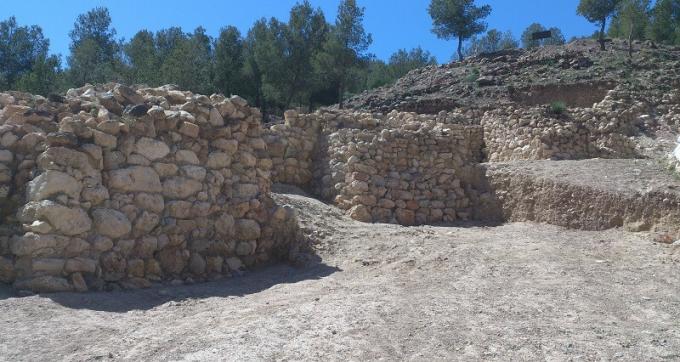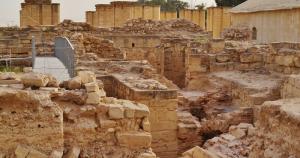Argaric culture: characteristics of this ancient Iberian civilization
the argaric culture It is one of the many that have passed through the territory of what is currently Spain.
We are going to immerse ourselves in a journey through the history of this town and thus know what their way of life was, what characterized and also what is the legacy that lasts to this day, in order to better understand a part of our own story.
- Related article: "The 7 types of lithic industry: the origins of technology"
What was and how was the Argaric culture?
The Argaric culture is a group of towns that settled in the southeastern part of the Iberian Peninsula, between 2300 a. c. and 1500 B.C. C., occupying lands that today make up the provinces of Alicante (Valencian Community), Murcia (Region of Murcia), Jaén and Granada (Andalusia).
It is one of the best representations of the European populations of the Bronze Age, and it is that Archaeological sites have been found that have allowed us to obtain a lot of information about these towns.
We owe the discovery of the Argaric culture to the brothers Luis and Enrique Siret, who in the last decades of the 19th century dedicated their careers to making excavations throughout the southeast of the peninsula, discovering the archaeological treasures that these lands hid and making known to the world the characteristics of the inhabitants of this territory, four millennia ago One of the most important deposits is in Antas (Almería), and is called El Argar, a name that baptizes Argaric culture.
The settlement of El Argar is located in the Sierra Almagrera, and in it, the Siret brothers came to find more than a thousand tombs belonging to the Argaric culture. But in addition to that site, they also explored other tremendously important ones, such as Ifre, Fuente Álamo, Gatas or El Oficio. Currently these places belong to the provinces of Murcia and Almería. The importance of these sites is given by all the material and structures that were found, in a magnificent state of conservation.
This way, found innumerable burials, many of them preserving the grave goods of the deceased, which made it possible to extract objects as diverse as knives, swords, spears, clay, bone or stone objects, clothing and even plant remains. With all this material, archaeologists have been able to carry out well-founded studies that allow us to know today the main characteristics and way of life of the inhabitants of the towns argarics
- You may be interested in: "The 6 stages of Prehistory"
Origin of this ancient civilization
There is some debate about the origin of the Argaric culture. Some historians and archaeologists believe that these peoples came from Greco-Mycenaean cultures. and that they settled in these coastal peninsular areas due to the wealth of metals such as tin, which allowed mining to be exploited.
However Other studies affirm that the Argaric culture is an evolution of pre-existing peoples in this territory., so they would not meet the hypothesis of colonization from other Mediterranean peoples.
Although the bulk of the Argaric populations are concentrated in Almería and Murcia, always in enclaves protected by geographical features such as elevations of the land, later other more remote settlements have been discovered, which even reach the area of Ciudad Real, and already in areas flatter. It is believed that the military culture of the Argarics allowed them to expand in search of more metal mines and more land where they could develop agriculture and livestock.
It is believed that the Argaric culture could have coexisted with other peoples of the Bronze AgeAlso called Chalcolithic. In some sites the possibility is observed that the settlements were built on existing ones, while in others it seems quite clear that they were built from scratch, without using the constructions or the previous distribution of other societies that had abandoned the place or had been conquered by the argarics
- You may be interested in: "Bronze Age: characteristics and phases of this historical period"

Characteristics of the Argaric peoples
The investigations of the deposits of the Argaric culture allow us to know its main characteristics. For example, we know that they used to be established in high places, as already mentioned, and in these locations created their buildings, usually rectangular in plan and sometimes in the shape of a trapezoid. The materials used were stone, adobe and rammed earth creations, walls made of clay and wooden formwork, very typical in Mediterranean cultures such as the Argaric.
In addition to the houses themselves, constructions dedicated to social activities are observed, such as warehouses, workshops and places to develop various professions. Some sites have walls for their defense against possible attacks by invaders, but many of them lack these fortifications, since that strategic locations in well-protected places were naturally enough defense, since they made any external attack very difficult.
It is believed that about 400 people lived in each town., although the largest ones could house even 600. These population centers had a series of services such as channeled drainage, cisterns to store water that they collected from a a nearby place, since they always settled next to a river, stables for the animals, barns to store food, and various elements to facilitate transit between different parts of the town, such as stairs or ramps to bridge differences of level.
One of the main characteristics of the Argaric culture is that they buried their dead on the land of the houses. For this they made pits or even used pithoi, large jars made of ceramic. Besides It was customary to make offerings that were buried next to the deceased, and the elements found have been tremendously useful to get an idea of the social hierarchy. existing in Argaric societies.
Although most graves house only one body, there are some cases of couples and even family groups sharing a niche. Similarly, tombs have been found with offerings but without a body, which indicates that they could not bury their mortal remains, perhaps because those individuals had died in some battle of which they did not they came back. The fact of perform a funeral ritual even without a body it is an indicator of certain religious thoughts that could indicate beliefs in a life after death.
Social structure
In the Argaric culture society was made up of a group of families with not many offspring. Thanks to the elements found in the tombs, it is believed that there would be five different social strata.
In the first place are the leading men of the town, carrying weapons and items made of precious metals. Then there would be their families, that is, their wives and children, who would also belong to the highest stratum of society.
Then there would be citizens with all rights, next to which more conventional metal weapons were deposited. This could include the soldiers of the city.
The fourth group is made up of people with more limited rights, perhaps artisans or peasants, whose trousseau were simple decorative elements. And finally there would be the individuals who were not honored with an offering. It is believed that they could be slaves or at least people with very limited rights within the Argaric society.
The role of women in this culture is not clear. It is believed that it would be subordinate to the man, but only within the social stratum or his superiors. In other words, belonging to a certain class weighed more heavily in terms of rights than being a man or a woman, which would be a second distinction. The elements found in the female graves suggest that they were dedicated to certain productive activities that provided economic value to Argaric society beyond the fact of creating offspring.
Economic activity
The Argaric culture was nourished by different productive activities. One of the most important was mining, and it was also key to choosing the place for the settlements, since they were usually close to mining areas, for example tin.
Likewise, they were great farmers, growing especially barley, which they later stored in granaries and then crushed using small mills, which were centralized in a very specific place within the town.
The Argarians also practiced animal husbandry, as opposed to hunting wild animals., which must be very low. In their territories they would house species such as horses, oxen, goats, sheep and pigs. They were also engaged in other activities such as ceramic manufacturing, creating objects with common shapes that suggests that they had certain patterns or criteria to follow to standardize the objects. In addition, the quality of his ceramics was very striking.
They also worked with other materials, such as the metallurgy itself with the metals they extracted from the mines, but also carving bones and also stones of different types and sizes.
Finally, another of its most outstanding industries would be textiles, since abundant evidence of creations made in linen has been found.
Bibliographic references:
- Ariza, R.S. (2012). Fortifications and status in the Argaric culture. Archeology and Territory.
- Garcia, E. A. (2007). Care practices in prehistoric societies: The Argaric culture. Archeology and Territory.
- Jiménez-Brobeil, S.A., Al Oumaoui, I., Esquivel, J.A. (2004). Physical activity according to sex in the Argaric culture. An approach from the human remains. Prehistoric works.
- Legarra, B. (2014). Territorial structure and state in the Argaric culture. Menga. Journal of Andalusian Archeology.


